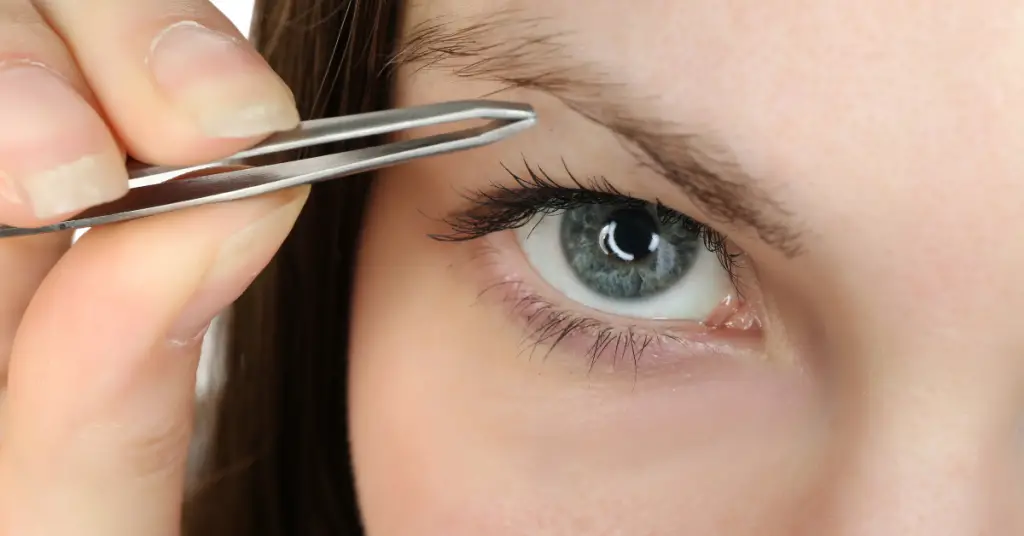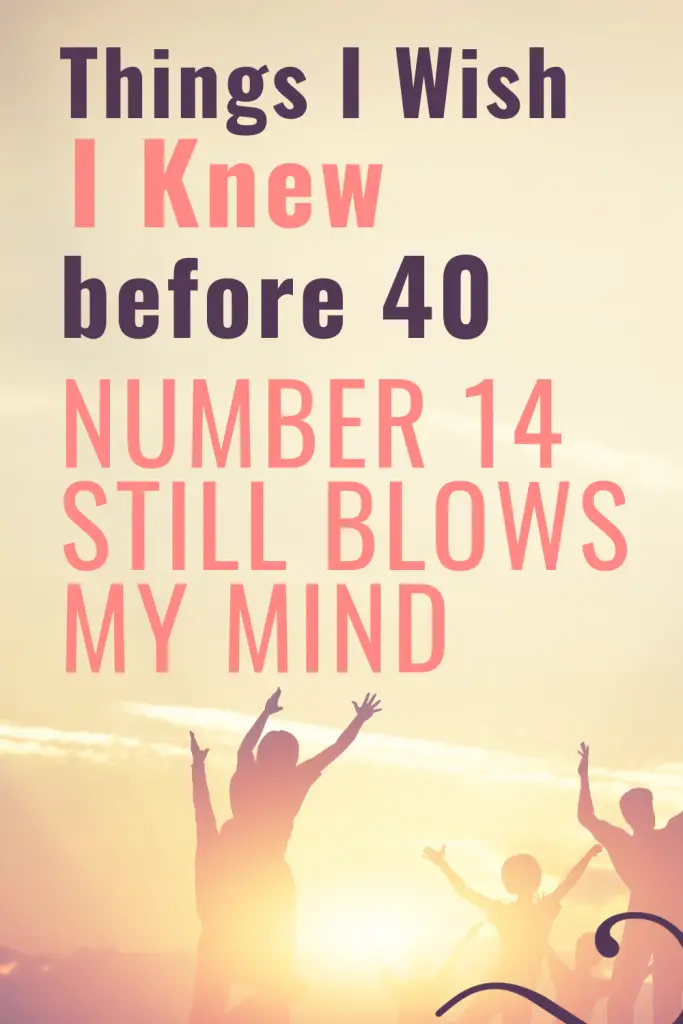The things I wish I knew before 40 reflect my personality and experience. I could think of many other essential life lessons like “Look for beauty in the small things,” “What people think about you is none of your business,” “Indecision is a decision,” “Learn to set boundaries,” “Cultivate happiness in challenges,” blah, blah, blah… But I wanted my life lessons to be less universal and more practical.
15 Things I Wish I Knew Before 40
From how to nourish and tone your body to ways to enjoy life and promote healthy relationships, here are the things I wish I knew before 40.

1. Stretching Isn’t Just Something You Skip at the End of Your Workouts
That used to be me! I saw no point in being flexible. I just wanted a toned and fit body. I didn’t know flexibility would become the stepping stone to using yoga to transform my body and fitness. Read my 1-Year Yoga Transformation: Before and After Pictures and Top 5 Flexibility Benefits I Personally Experienced After 40 to learn more. Of course, since I started training for flexibility after 40, progress has been slower, but it is one of the most rewarding and life-changing habits I ever created.
2. Intermittent Fasting Doesn’t Mean Skipping Breakfast
Did you know you can use intermittent fasting to biohack to lose weight without counting calories and reduce food cravings? And it’s not skipping breakfast (the 16:8 method).
Like many other women, I struggled with food cravings most of my life. Here are some common symptoms I experienced:
- Food cravings: Wanting to eat when not hungry.
- Needing something sweet: After a meal, needing to eat something sweet.
- Feeling hangry: Having a hard time going without food between meals.
- Feelings of guilt around food: Feeling guilty because of a lack of self-control.
- Fatigue and signs of inflammation: Bloating, puffiness, redness of the face, etc.
Consequently, I couldn’t lose weight no matter what I tired. Fasting enabled me to heal my body and improve my insulin sensitivity (which is essential to conquering food cravings). The key here is to achieve optimal weight loss ketosis whenever you fast. This means you will likely fast for at least 20 hours, but you will not be fasting every day. Read How I Lost Weight After 40: My Success Story for more details about my weight loss journey.
3. Start Yoga NOW!
I used to think that yoga looked boring and easy. As a busy mom and NASM personal trainer, I focused on what I thought were the most effective workouts: High-Intensity Interval Training and lifting dumbbells. I started doing yoga at the age of 43, mostly because I wanted to learn to do the headstand and the splits,
After only six months, I saw more definition in my abs, arms, and shoulders than ever. I improved my cardiovascular capacity and flexibility, stopped suffering from back pain, and felt energized and strong! Yoga quickly became my passion, so I got my 500-hour yoga instructor certification. Not sure why I didn’t see similar results with dumbells. I know many gym girls look strong and toned. Maybe it is because I don’t particularly appreciate pushing myself hard. Yoga helps me ride the edge of my abilities.
There are numerous benefits to practicing yoga regularly. Here are some of the most significant ones:
- Reduces stress: Yoga helps reduce stress by promoting relaxation, calming the mind, and reducing cortisol levels in the body.
- Improves flexibility and balance: Yoga poses help improve flexibility, range of motion, and balance, which can help prevent falls and injuries.
- Strengthens muscles: Many yoga poses involve holding positions that require strength and endurance, which helps to build muscle tone and improve overall strength.
- Boosts immune system: Practicing yoga has been shown to boost the immune system by increasing levels of antibodies that fight infection.
- Improves sleep: Yoga helps promote relaxation and reduce stress, which can lead to improved sleep quality and duration.
- Relieves pain: Yoga can help relieve chronic pain, including back pain, arthritis, and headaches, by improving flexibility and reducing inflammation.
- Promotes mental clarity: Practicing yoga can help improve focus, concentration, and mental clarity by calming the mind and reducing stress.
- Enhances cardiovascular health: Yoga can improve cardiovascular health by reducing blood pressure, improving circulation, and reducing the risk of heart disease.
- Increases self-awareness: Yoga promotes mindfulness and introspection, which can lead to greater self-understanding and personal growth.
- Cultivates a sense of inner peace: Regular yoga can promote inner peace and well-being by reducing stress, increasing mindfulness, and improving overall physical and mental health.
Remember, the benefits of yoga are numerous and can vary from person to person. Incorporating yoga into your wellness routine can help you feel more centered, energized, and connected to yourself and others. Would you like some help to get started with yoga? Consider joining my free 5-Day Yoga Habit Challenge.
4. How to Use Nutrition to Boost Energy, Mood, and Overall Well-Being
When struggling with headaches, allergies, and fatigue, I tried all the healing protocols under the sun, from raw vegan to Paleo and keto. I would get extensive meal plans, spend tons of money on groceries and supplements, and hours in the kitchen. In my forties, after a decade of learning and experimenting, I started streamlining my nutrition to some simple essentials:
- Avoid gluten completely.
- Strictly limit dairy.
- Make fruits and vegetables the bulk of your diet (whether cooked or raw).
- Limit grains
- Supplement with vitamin D during the Winter months (absolutely critical for me).
- Find a whole food multivitamin (I use the PowerShake and love it. I notice an increase in my energy level when I take it).
- Fast for 20-24 hours once a week or once every two weeks (read How Fasting for 20 Hours Benefits You and Top 8 Most Compelling Benefits of a 24-Hour Fast for more info).
Read What to Eat on Intermittent Fasting for Weight Loss for more food guidelines.
5. Choose Your Sources of Dopamine Intentionally
Dopamine is a neurotransmitter associated with feelings of pleasure, reward, motivation, and happiness. It is often called the “feel-good” chemical in the brain. However, dopamine can be addictive, and the brain can become dependent on it. Therefore, it is essential to choose your sources of dopamine carefully.
For most of my life, I relied on harmful dopamine sources, like overspending, overeating, and even drugs or alcohol. Choosing healthy sources of dopamine leads to positive outcomes. For example, engaging in physical activity, spending time with loved ones, and accomplishing goals can all release dopamine in the brain, leading to feelings of pleasure, reward, and motivation. By focusing on healthy sources of dopamine, you can improve your overall well-being and sustainably achieve your goals, reduce self-destructive behaviors, and avoid addictions.

6. Ensure Your Body Runs on Ketones Regularly
Even after fasting, you must be conscious of how your body reacts to your eating style to reduce food cravings and lose weight. The less frequently you fast, you may notice your energy levels dipping as inflammation increases. You need to continue with the biohacking by making sure your body runs on ketones regularly. You can try other tools besides the 20-24 hour fasting window. Consider a keto cycle (read How to Keto Diet for Weight Loss and Health: Wait! It’s Not What You Think!) or the Fasting Mimicking Diet (Modified Fasting: How You Can Benefit From Fasting Without Starving).
7. Beware of Dogma
In my younger days, I thrived in a world of black and white. I wanted answers. I wanted to know what doing the “right” thing was and make sure I was doing it. Whether it was my parenting style, my eating style, my views on marriage, or what it meant to live a fulfilling life, I couldn’t see that many things I thought were “truths” were my truths. It didn’t mean they were wrong if someone else was doing something else. It’s comforting to believe we have all the answers, but if we were honest with ourselves, we would have to admit that we rarely do and that truth is elusive.
8. Make Money Doing the Things You Love
Before having children, I was a translator. Then, I became a translator part-time until I had my fifth baby. I became heavily involved in health and wellness, but it never occurred to me to get certified as a health coach, then a NASM personal trainer, then a yoga instructor until my forties. If you are passionate about something, go for it! Find a way to earn an income doing what you love, not necessarily as a full-time income but as a side hustle. The point is to create multiple streams of income with your passions.
9. Create Habits to Become the Person You Wish to Be
Too often, we think we fail because we lack self-discipline when what we need is to learn to create healthy habits. As James Clear puts it: Your current life is the sum of your habits. You do not rise to the level of your goals; you fall to the level of your systems. Your goals are what you want to achieve the desired outcome. The collection of your habits is your system.
When you optimize your habits, you optimize the system. If there is a gap between your goals and your system, the system always wins. It doesn’t matter what your intentions were. It doesn’t matter what you hope to achieve; your habits will win.
It’s not your fault if you have inherited unhelpful habits, but it is your responsibility to figure out how to adjust them in a meaningful way. Want some help to get started? Check out my 5-Day Yoga Habit Challenge.
10. Honesty Isn’t Always the Best Policy
I don’t particularly appreciate trying to guess what people are thinking. I would much prefer it if they just told me! Consequently, I haven’t displayed much discernment in most of my relationships and said my piece when I should have kept quiet. People don’t always need to hear what you think, even when you believe it would be helpful (because your perception of other people’s situation is surely helpful, right?). Wrong! And that is one of the things I wish I knew before 40.
11. Stop Plucking Your Eyebrows
Haha! Seriously! Why did we pluck our eyebrows so thin?

12. Enter Marriage as a Partnership, Not a Social Contract
I married at 24, considering marriage an unnamed agreement rather than a partnership. I believed my husband had specific responsibilities, and I had different responsibilities. Many were not fluid, like it or not. This meant that my husband had to do things he didn’t want to do, like going to work, and in return, I had to provide comfort, specifically sex and household duties.
I learned that this type of contract relationship usually means men and women submit to outward requirements in their relationship without being able to reshape their responsibilities and expectations, even if one of the parties would like to. They often come into the marriage with traditional gender roles that leave little room for growth. People change, relationships change, and both partners must be willing to change together.
13. Acquire Two Easy Habits to Reduce Insomnia
Sleep is essential to your overall health and well-being. Fortunately, I didn’t struggle with sleep much over my life except during my pregnancies. After 40, on the other hand, I started struggling with insomnia regularly. Here are the two main things that helped me:
- Supplement with magnesium before bed (read How to Improve Sleep During Perimenopause).
- Adhere to a strict sleep schedule with an early bedtime (read How to Wake Up at 5 am and Create a Morning Routine).

14. Harness the Power of Your Inner Energy
Aside from the fact that your thoughts will create your feelings which will then create your actions, your inner energy will impact your reality to some extent. Your thoughts and words send electrical impulses and energy into the world around you (including plants). Your perception of reality affects your reality, even creating new pathways in your brain. Conversely, how you perceive reality is subjective, depending on how your brain interprets electrical impulses from the world.
The best way to harness the power of your inner energy is mindfulness. For example, since I desire a calmer energy, I purposely feel peaceful and calm whenever I work on mechanical tasks that don’t require much focus. I try to remember to use a deeper, more soothing voice when I speak. Whenever I notice my nervous energy, I observe it. Then, I determine how to experience calm in the same scenario. I experience how these energies manifest in my body.
The idea is to decide what energy you want to harness and then put it to work. If you aren’t sure what I mean by “energy,” an excellent place to start might be reading about balancing your masculine and feminine energies.
15. Practice Mindfulness to Be Present in the Moment
There are many ways to be present in the moment:
- Pay attention to those around you.
- Observe body language.
- Breathe in the smells.
- Notice small details in your surroundings.
- Be aware of your body and your posture.
- Notice if you are frowning.
- Examine your thoughts.
- Experience your feelings.
- Learn to meditate.
Things I Wish I Knew Before 40 Video
In Summary
My advice for turning 40 is to stop fearing turning 40 and aging overall. I have never been happier in my skin since turning 40. It discovered that 40 is important because it is when you are just old enough to have gained wisdom and feel comfortable in your skin and young enough to enjoy a fit body. Instead of looking at middle age as a “crisis” age, let’s rediscover it for what it is: the perfect balance age. It’s an age when you learn not to give a F***. You have more mental strength while enjoying your physical health and strength.





